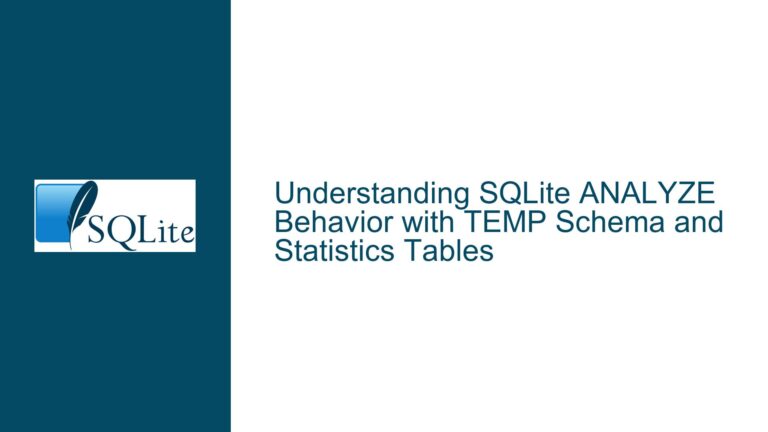SQLite Subquery Correlation and Performance Implications
SQLite Subquery Correlation and Determinism in Query Optimization
SQLite, like many relational database management systems, employs a query optimizer to determine the most efficient way to execute a given SQL statement. One of the key decisions the optimizer must make is whether a subquery is correlated or not. This decision has significant implications for query performance, as it affects whether the subquery is executed once or repeatedly for each row in the outer query. The distinction between correlated and non-correlated subqueries is not always intuitive, especially when dealing with non-deterministic functions or complex query structures.
In the context of SQLite, a subquery is considered correlated if it references a column from the outer query. This means that the subquery must be re-evaluated for each row of the outer query, as the result of the subquery depends on the values of the outer query’s columns. On the other hand, a non-correlated subquery is independent of the outer query and can be evaluated once, with its result reused across all rows of the outer query.
The confusion often arises when dealing with constructs like IN and EXISTS, which can behave differently depending on whether the subquery is correlated or not. For example, consider the following query:
WITH lucky_numbers(lucky_number) AS (
SELECT x
FROM natural_numbers
ORDER BY RANDOM()
LIMIT 5
)
SELECT SUM(x IN lucky_numbers)
FROM natural_numbers;
In this case, the subquery (x IN lucky_numbers) is not considered correlated because it does not reference any columns from the outer query. As a result, SQLite’s optimizer might decide to evaluate the subquery only once and reuse the result for all rows in the outer query. This can lead to unexpected behavior, especially when the subquery involves non-deterministic functions like RANDOM().
In contrast, the following query uses EXISTS with a correlated subquery:
WITH lucky_numbers(lucky_number) AS (
SELECT x
FROM natural_numbers
ORDER BY RANDOM()
LIMIT 5
)
SELECT SUM(EXISTS(
SELECT 1
FROM lucky_numbers
WHERE x = lucky_number
))
FROM natural_numbers;
Here, the subquery (SELECT 1 FROM lucky_numbers WHERE x = lucky_number) is explicitly correlated because it references the column x from the outer query. As a result, SQLite’s optimizer will re-evaluate the subquery for each row in the outer query, ensuring that the non-deterministic behavior of RANDOM() is preserved.
The key takeaway is that SQLite’s optimizer does not consider the determinism of a subquery when deciding whether it is correlated or not. Instead, the decision is based solely on whether the subquery references any columns from the outer query. This can lead to performance differences and unexpected results, especially when dealing with non-deterministic functions.
Non-Deterministic Functions and Subquery Independence
One of the most critical aspects of understanding subquery correlation in SQLite is recognizing the role of non-deterministic functions. A non-deterministic function is one that can return different results each time it is called, even with the same input. Examples of non-deterministic functions in SQLite include RANDOM(), CURRENT_TIMESTAMP, and ROWID.
When a subquery contains a non-deterministic function, the result of the subquery can vary depending on when and how often it is executed. This variability can lead to significant performance differences and unexpected results, especially if the subquery is mistakenly treated as non-correlated.
Consider the following example:
WITH lucky_numbers(lucky_number) AS (
SELECT x
FROM natural_numbers
ORDER BY RANDOM()
LIMIT 5
)
SELECT SUM(x IN lucky_numbers)
FROM natural_numbers;
In this query, the subquery (x IN lucky_numbers) is non-correlated because it does not reference any columns from the outer query. As a result, SQLite’s optimizer might decide to evaluate the subquery only once and reuse the result for all rows in the outer query. However, because the subquery involves the non-deterministic function RANDOM(), this can lead to incorrect results. Specifically, the same set of "lucky numbers" will be used for all rows in the outer query, which may not be the intended behavior.
To avoid this issue, it is essential to ensure that subqueries involving non-deterministic functions are explicitly correlated. This can be achieved by referencing a column from the outer query within the subquery, as shown in the following example:
WITH lucky_numbers(lucky_number) AS (
SELECT x
FROM natural_numbers
ORDER BY RANDOM()
LIMIT 5
)
SELECT SUM(EXISTS(
SELECT 1
FROM lucky_numbers
WHERE x = lucky_number
))
FROM natural_numbers;
In this query, the subquery (SELECT 1 FROM lucky_numbers WHERE x = lucky_number) is explicitly correlated because it references the column x from the outer query. As a result, SQLite’s optimizer will re-evaluate the subquery for each row in the outer query, ensuring that the non-deterministic behavior of RANDOM() is preserved.
It is also worth noting that SQLite’s optimizer assumes that the result of a subquery is deterministic and stable. This assumption is fundamental to the operation of the database and is based on the principle that the same input should always produce the same output. When this assumption is violated, as in the case of non-deterministic functions, the optimizer’s decisions may lead to unexpected results.
Optimizing Subqueries with PRAGMA Statements and Query Refactoring
To address the performance and correctness issues associated with subquery correlation and non-deterministic functions, it is essential to understand how to optimize subqueries in SQLite. This can be achieved through a combination of PRAGMA statements, query refactoring, and careful consideration of the underlying data model.
One of the most effective ways to optimize subqueries in SQLite is to use the PRAGMA journal_mode statement. The journal_mode PRAGMA controls how SQLite handles transaction rollback and recovery, which can have a significant impact on query performance. For example, setting the journal mode to WAL (Write-Ahead Logging) can improve performance by allowing concurrent reads and writes, while setting it to TRUNCATE can reduce the overhead of journaling.
Another important consideration is the use of temporary tables and indexes. In some cases, it may be beneficial to materialize the results of a subquery into a temporary table and create an index on the relevant columns. This can reduce the overhead of repeatedly evaluating the subquery and improve overall query performance.
For example, consider the following query:
WITH lucky_numbers(lucky_number) AS (
SELECT x
FROM natural_numbers
ORDER BY RANDOM()
LIMIT 5
)
SELECT SUM(x IN lucky_numbers)
FROM natural_numbers;
To optimize this query, we can materialize the lucky_numbers subquery into a temporary table and create an index on the lucky_number column:
CREATE TEMP TABLE temp_lucky_numbers AS
SELECT x AS lucky_number
FROM natural_numbers
ORDER BY RANDOM()
LIMIT 5;
CREATE INDEX idx_temp_lucky_numbers ON temp_lucky_numbers(lucky_number);
SELECT SUM(x IN (SELECT lucky_number FROM temp_lucky_numbers))
FROM natural_numbers;
By materializing the subquery into a temporary table and creating an index, we can reduce the overhead of repeatedly evaluating the subquery and improve query performance.
In addition to using PRAGMA statements and temporary tables, it is also important to consider the overall structure of the query. In some cases, refactoring the query to eliminate unnecessary subqueries or simplify the logic can lead to significant performance improvements.
For example, consider the following query:
WITH lucky_numbers(lucky_number) AS (
SELECT x
FROM natural_numbers
ORDER BY RANDOM()
LIMIT 5
)
SELECT SUM(EXISTS(
SELECT 1
FROM lucky_numbers
WHERE x = lucky_number
))
FROM natural_numbers;
This query can be refactored to eliminate the need for a correlated subquery by using a JOIN instead:
WITH lucky_numbers(lucky_number) AS (
SELECT x
FROM natural_numbers
ORDER BY RANDOM()
LIMIT 5
)
SELECT COUNT(*)
FROM natural_numbers
JOIN lucky_numbers ON natural_numbers.x = lucky_numbers.lucky_number;
By refactoring the query to use a JOIN instead of a correlated subquery, we can simplify the logic and improve query performance.
In conclusion, understanding the nuances of subquery correlation and non-deterministic functions is essential for optimizing query performance in SQLite. By using PRAGMA statements, materializing subqueries into temporary tables, and refactoring queries to eliminate unnecessary complexity, it is possible to achieve significant performance improvements and ensure correct results.






